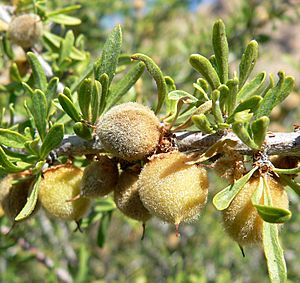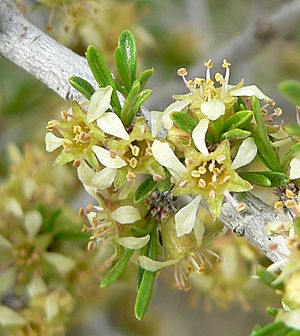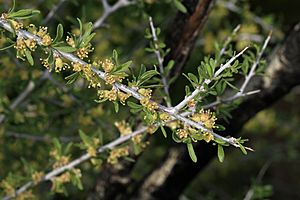Wild almond facts for kids
Quick facts for kids Wild almond |
|
|---|---|
 |
|
| Scientific classification | |
| Synonyms | |
|
The Prunus fasciculata, also known as wild almond, desert almond, or desert peach, is a spiny, woody shrub. It grows wild almonds and is found in the deserts of Arizona, California, Baja California, Nevada, and Utah.
This plant lives for many years, which means it is perennial. It also drops its leaves every year, making it deciduous. It prefers to grow in sandy or rocky soil on dry hillsides and in dry riverbeds. You can usually find it below 7,000 feet (2,100 m) in elevation.
Contents
What Does the Desert Almond Look Like?
The desert almond plant can grow up to 2 metres (6 ft 6.7 in) tall. Sometimes, it can even reach 3 metres (9.8 ft)! It has many branches that spread out and often have thorns. These branches can grow so close together that they form thick bushes. The bark on the branches is grey and smooth.
Its leaves are small, about 5–20 millimetres (0.2–0.8 in) long, and narrow. They have a wide, flat tip that gets narrower towards the base. These leaves grow in small bundles, like tiny bunches of needles. The flowers are small and white, with petals about 3 mm long. They grow either alone or in bundles from where the leaves meet the stem.
Some desert almond plants have only male flowers, and others have only female flowers. This is called being dioecious. Male flowers have 10 to 15 parts that make pollen, called stamens. Female flowers have one or more parts that will become the fruit, called pistils. The plant has many sweet-smelling flowers from March to May. These flowers attract bees, which help the plant make seeds. The fruit is a small, light brown, oval-shaped drupe about 1 cm long. It has soft hairs and a thin layer of fruit flesh.
How People Use the Desert Almond
People do not usually grow the desert almond in gardens or farms. However, some Native American groups living in the desert learned how to use it. The Cahuilla people, for example, prepared the wild almonds as a special food.
The Kawaiisu people found the plant's tough, thin branches very useful. They used them as parts of drills to start fires. They also used them for the front part of their arrow shafts. The seeds of the desert almond naturally contain a chemical that makes them unsafe to eat raw. However, ancient people in the Mojave desert found ways to prepare the seeds. They would pound them into flour and wash them to remove the harmful chemicals, making them safe to eat.
Naming the Desert Almond
The desert almond was first given a scientific name, Emplectocladus fasciculata, in 1853. This name was given by John Torrey. He studied plants collected during an expedition by John C. Frémont in 1845. The name Emplectocladus means "woven branch" in Greek. This describes how the plant's branches are so dense and tangled.
The second part of the name, fasciculata, means that the leaves grow in small bundles, or "fascicles." Later, in 1874, another scientist named Asa Gray reclassified the plant. He moved it into the Prunus group, which includes almonds, peaches, and cherries. This is why its scientific name today is Prunus fasciculata.
Desert Almond in Ancient Times
Scientists can learn a lot about ancient plants by studying things left behind by small animals like Pack rats. These animals collect plant pieces in their nests, called middens. These middens can be a rich source of plant fossils from thousands of years ago.
For example, in Nevada, around 11,700 years ago, desert plants like the desert almond started to grow where Juniper and Joshua trees once were. This shows that the desert climate we know today was beginning to form. Even earlier, between 17,000 and 14,000 years ago, the desert almond thrived in a mix of desert and woodland areas on the Colorado Plateau.
Archaeological findings also suggest that ancient people living in the Mojave desert used the seeds of the desert almond. They would grind the seeds into flour and wash them to remove any harmful substances, making them safe to eat.



